 Predicted antideuteron flux as a function of kinetic energy per nucleon for several dark matter candidates.
The expected GAPS sensitivity is shown in gray.
Figure adapted from Aramaki et al., 2016.
Predicted antideuteron flux as a function of kinetic energy per nucleon for several dark matter candidates.
The expected GAPS sensitivity is shown in gray.
Figure adapted from Aramaki et al., 2016.
The General AntiParticle Spectrometer (GAPS) aims to study dark matter through sensitive observations of cosmic-ray antiprotons, antideuterons, and antihelium. The science goals of the GAPS experiment are:
- Perform a sensitive low-energy (< 0.25 GeV/n) antideuteron search; a search for a generic new physics signature with a very low conventional astrophysical background.
- Precisely measure the cosmic-ray antiproton spectrum at low energies, constraining dark matter models, primordial black hole evaporation, and conventional cosmic-ray physics (e.g. solar modulation, cosmic-ray propagation)
- Follow up on candidate antihelium events reported by AMS-02. These antihelium cosmic rays, if dark matter related, would also imply a large antideuteron signal easily detectable by GAPS.
- Serve as a pathfinder for more sensitive satellite-based experiments or ULDB experiments utilizing multiple instruments/multiple launches in the future.
Many dark matter theories predict high antiproton and antideuteron fluxes below ~1 GeV, including some neutralinos, Kaluza-Klein neutrinos, and gravitinos. While ordinary matter cosmic rays are abundantly produced and accelerated at astrophysical sources (so called "primaries"), the astrophysical cosmic-ray antimatter background comes mainly from the spallation of primaries on the interstellar medium ("secondaries"). Spallation reactions result in the creation of very few low-energy particles due to kinematics, and energy-loss mechanisms also operate less efficiently on antideuterons (compared to antiprotons), resulting in a highly suppressed antideuteron flux at low energies. The antideuteron search exploits both the enhanced dark matter signal and background suppression in the low-energy antideuteron spectrum.
GAPS will fly over Antarctica using a long-duration balloon. The long observation time and low geomagnetic cutoff rigidity near the South Pole allow GAPS to achieve its high sensitivity extending toward low energies.
 Illustration of the basic principle behind three of the four methods of dark matter.
Illustration of the basic principle behind three of the four methods of dark matter.
 Detection principle of the GAPS experiment. An antideuteron (black) enters the detector and slows down, depositing ever larger amounts of energy in the ToF and tracker, then stops in the Si(Li) target, forming an exotic atom. As the atom de-excites, X-rays (red) are emitted at characteristic energies. The atom then annihilates, producing pions (purple) and protons.
Figure adapted from
Detection principle of the GAPS experiment. An antideuteron (black) enters the detector and slows down, depositing ever larger amounts of energy in the ToF and tracker, then stops in the Si(Li) target, forming an exotic atom. As the atom de-excites, X-rays (red) are emitted at characteristic energies. The atom then annihilates, producing pions (purple) and protons.
Figure adapted from